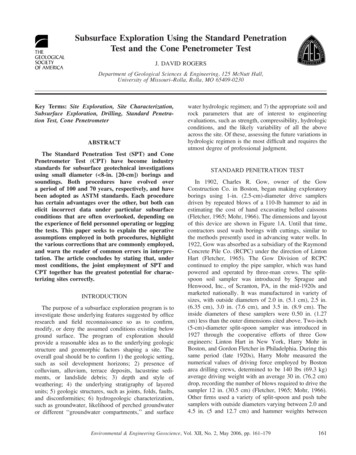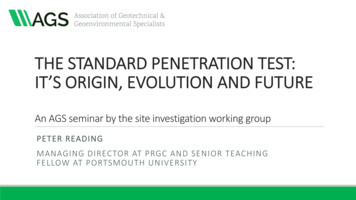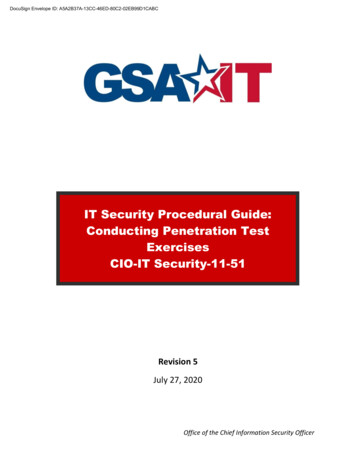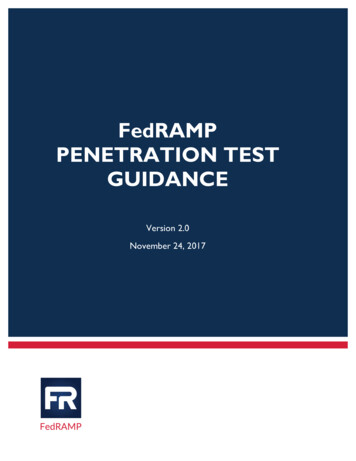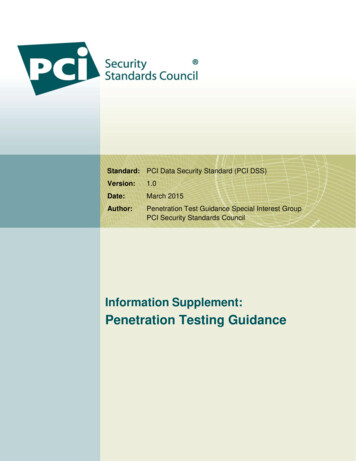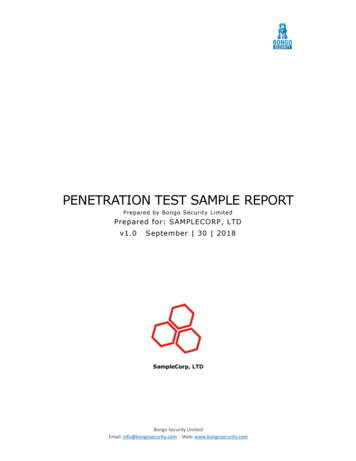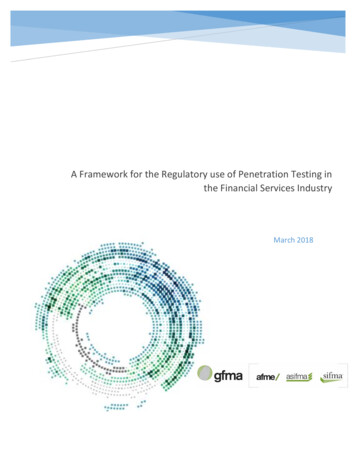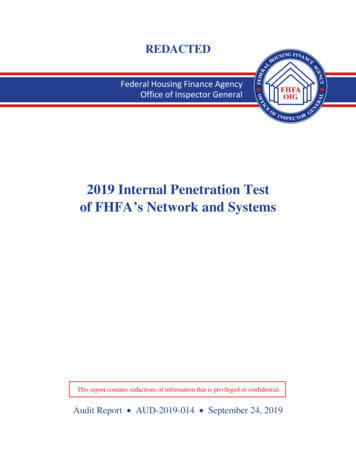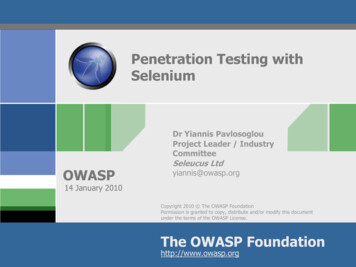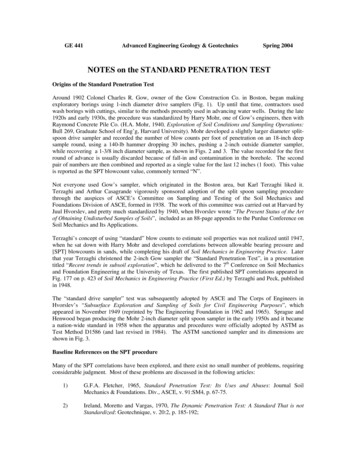
Transcription
GE 441Advanced Engineering Geology & GeotechnicsSpring 2004NOTES on the STANDARD PENETRATION TESTOrigins of the Standard Penetration TestAround 1902 Colonel Charles R. Gow, owner of the Gow Construction Co. in Boston, began makingexploratory borings using 1-inch diameter drive samplers (Fig. 1). Up until that time, contractors usedwash borings with cuttings, similar to the methods presently used in advancing water wells. During the late1920s and early 1930s, the procedure was standardized by Harry Mohr, one of Gow’s engineers, then withRaymond Concrete Pile Co. (H.A. Mohr, 1940, Exploration of Soil Conditions and Sampling Operations:Bull 269, Graduate School of Eng’g, Harvard University). Mohr developed a slightly larger diameter splitspoon drive sampler and recorded the number of blow counts per foot of penetration on an 18-inch deepsample round, using a 140-lb hammer dropping 30 inches, pushing a 2-inch outside diameter sampler,while recovering a 1-3/8 inch diameter sample, as shown in Figs. 2 and 3. The value recorded for the firstround of advance is usually discarded because of fall-in and contamination in the borehole. The secondpair of numbers are then combined and reported as a single value for the last 12 inches (1 foot). This valueis reported as the SPT blowcount value, commonly termed “N”.Not everyone used Gow’s sampler, which originated in the Boston area, but Karl Terzaghi liked it.Terzaghi and Arthur Casagrande vigorously sponsored adoption of the split spoon sampling procedurethrough the auspices of ASCE’s Committee on Sampling and Testing of the Soil Mechanics andFoundations Division of ASCE, formed in 1938. The work of this committee was carried out at Harvard byJuul Hvorslev, and pretty much standardized by 1940, when Hvorslev wrote “The Present Status of the Artof Obtaining Undisturbed Samples of Soils”, included as an 88-page appendix to the Purdue Conference onSoil Mechanics and Its Applications.Terzaghi’s concept of using “standard” blow counts to estimate soil properties was not realized until 1947,when he sat down with Harry Mohr and developed correlations between allowable bearing pressure and[SPT] blowcounts in sands, while completing his draft of Soil Mechanics in Engineering Practice. Laterthat year Terzaghi christened the 2-inch Gow sampler the “Standard Penetration Test”, in a presentationtitled “Recent trends in subsoil exploration”, which he delivered to the 7th Conference on Soil Mechanicsand Foundation Engineering at the University of Texas. The first published SPT correlations appeared inFig. 177 on p. 423 of Soil Mechanics in Engineering Practice (First Ed.) by Terzaghi and Peck, publishedin 1948.The “standard drive sampler” test was subsequently adopted by ASCE and The Corps of Engineers inHvorslev’s “Subsurface Exploration and Sampling of Soils for Civil Engineering Purposes”, whichappeared in November 1949 (reprinted by The Engineering Foundation in 1962 and 1965). Sprague andHenwood began producing the Mohr 2-inch diameter split spoon sampler in the early 1950s and it becamea nation-wide standard in 1958 when the apparatus and procedures were officially adopted by ASTM asTest Method D1586 (and last revised in 1984). The ASTM sanctioned sampler and its dimensions areshown in Fig. 3.Baseline References on the SPT procedureMany of the SPT correlations have been explored, and there exist no small number of problems, requiringconsiderable judgment. Most of these problems are discussed in the following articles:1)G.F.A. Fletcher, 1965, Standard Penetration Test: Its Uses and Abuses: Journal SoilMechanics & Foundations. Div., ASCE, v. 91:SM4, p. 67-75.2)Ireland, Moretto and Vargas, 1970, The Dynamic Penetration Test: A Standard That is notStandardized: Geotechnique, v. 20:2, p. 185-192;
Figure 1 (above left) – The original Gow Pipe Sampler utilized 1-inch diameter drill rod and 1-inchdiameter pipe with a beveled cutting tip. It was introduced around 1902.Figure 2 (above right) – Components of SPT spilt spoon sampler, as developed by Harry Mohr in theearly 1930s, after Gow Construction had been absorbed by the Raymond Concrete Pile Company.Figure 3 – Standard dimensions for the SPT sampler, as given in ASTM D1586.
3)V.F.B. de Mello, 1971, The Standard Penetration Test: Proceedings of the 4th PanamericanConference on Soil Mechanics and Foundation Engineering: San Juan, PR, v.1:1-86; and4)Yves Lacroix and Harry Horn, 1973, Direct Determination and Indirect Evaluation ofRelative Density and Its Use on Earthwork Construction Projects: in Evaluation of RelativeDensity and Its Role in Geotechnical Projects Involving Cohesionless Soils: ASTM SpecialTechnical Publication 523, p. 251-280.In 1986 a series of new correlations and corrections were introduced, which are in current usage. Theseinclude:5)C.O. Riggs, 1986, North American Standard Penetration Test practice: An essay: in Use ofInsitu Tests in Geotechnical Engineering, ASCE Geotechnical Special Publication No. 6;6)A.W. Skempton, 1986, Standard Penetration Test Procedures and the Effects in Sands ofOverburden Pressure, Relative Density, Particle Size, Aging and Overconsolidation:Geotechnique, v. 36:3, p. 425-447; and7)S.S.C. Liao and R.V. Whitman, 1986, Overburden Correction Factors for SPT in Sand:Journal of Geotechnical Engineering, A.S.C.E., v. 112:3, p. 373-377.In 1990, Clayton presented an expanded listing of SPT hammer efficiencies (Em) in:8)C.R.I. Clayton, 1990, SPT Energy Transmission: Theory, Measurement, and Significance:Ground Engineering, v. 23:10, p. 35-43.For evaluation of liquefaction potential, raw SPT blowcounts must be corrected to (N1)60 values, asdescribed in the following sections.Burmister’s (1948) input energy correctionDespite all the encouragement to adopt Terzaghi’s SPT test, most people went on using whatever devices theyhad previously, until more and more of Casagrande’s students infiltrated the ranks of foundation engineering.In the New York area the favored device was the 3.625-inch diameter Moran & Proctor, or M & P Sampler,which had been developed by Carlton Proctor for the firm’s exploration of the San Francisco Bay Bridgeproject (C. S. Proctor, 1936, The Foundations of the San Francisco-Oakland Bay Bridge: Proceedings of theInt’l Conference on Soil Mechanics and Foundation Engineering, Harvard Univ., v.3, p. 183-193). The M & Psampler allowed recovery of a much larger 3-inch diameter samples, using 5000 in-lbs. per blow in lieu of theSPT’s 4,200 in-lbs. The M & P sampler is shown in Fig. 4. Moran & Proctor engaged Professor DonBurmister of Columbia University to develop a scheme for correlating M & P sampler blow counts with thoseof Mohr’s SPT sampler, commonly employed in New England and elsewhere (after 1948). Burmister assumedthat SPT blowcounts relate energy input versus the area of the sampler barrel and sample. He reasoned thatsimple correlations could be made between the various size samplers by ignoring the increase in skin frictionarea that accompanies larger diameter samplers and increasing skin friction with depth. Despite the simplisticphysics, these rough correlations have proven valuable in practice. Burmister suggested a simple input energycorrection for the ratio of driving weight (hammer energy) versus sample diameter, published as: D.M.Burmister, 1948, The importance and practical use of relative density in soil mechanics: Proceedings of ASTM,v. 48:1249. Burmister’s relationship only considered energy input (weight of hammer multiplied by dropheight), size of the recovered sample (Di) and sample barrel diameter (Do).This could be rewritten to provide input energy and diameter correction for other tests to correlate with theSPT (ASTM D-1586):- (1.375 in)2 ]N* NR (W lbs) (H in) [ (2.0 in)222(140 lb) (30 in)( Do ) - (Di )
Where W is the hammer weight, H is the height of the drop, Do is the outside diameter of the sample barrel,Di is the diameter of the drive sample, NR is the raw blow count, and N* is the blowcount reported as theequivalent SPT value. The Burmister energy correction takes the raw “SPT” blow count value andmultiplies it by an appropriate fraction, derived from the relationship above. The corrected blowcountvalue is usually denoted by an asterisk (*) on the boring log, with a note explaining that the blow countshave been adjusted.If we apply Burmister’s simple equation to the Modified California sample barrel, with an outside diameterof 3.0 inches and a sample diameter of 2.4 inches, the calculated correction would be 0.65. This means theequivalent SPT N values would be about 65% of those recorded with the Modified California apparatus.Most workers cite Burmister’s 1948 “correction” for adjusted blow counts recorded with larger diameterdrive samplers, or for lower energy hammers (such as the 70-lb hammer used with Mobile Drilling’sMinuteman portable drilling rig).Figure 4 – The M & P drive sampler was developed by Carlton Proctor of Moran & Proctor in the early1930s. It was the preferred drive sampler in the New York City area because it recovers a less disturbedsample than the smaller diameter SPT.Lacroix and Horn (1973) correctionIn 1973 Yves Lacroix and Harry Horn of Woodward-Clyde wrote an article titled “Direct Determinationand Indirect Evaluation of Relative Density and Its Use on Earthwork Construction Projects”, published in
Evaluation of Relative Density and Its Role in Geotechnical Projects Involving Cohesionless Soils: ASTMSpecial Technical Publication 523, p. 251-280. This ASTM conference had been held in Los Angeles inJune 1972, and the correction proposed by Lacroix and Horn was subsequently adopted by manygeotechnical practioners when working close to geologic contacts with stiffer materials.Lacroix and Horn (1973) proposed that nonstandard penetration resistance, N1, could be correlated withStandard Penetration Resistance, N, for drive samples or a solid conical point, such as a static cone, whichincorporated consideration of driving energy and distance of penetration. They reasoned that the energyrequired to drive the sampler or cone a given distance or “depth” (L) was directly proportional to the squareof the outside diameter (D) and the distance of penetration, and inversely proportional to the energy perblow (Weight of hammer multiplied by the height of drop, WH):N N1 (2 in/D1)2 x 12 in/L1 x W1 /140 lb x H1 /30 in 2 N1W1H1175 D2 L1When this correction is applied to the Modified California sampler (Do 3.0 in., and Di 2.4 in), thepredicted correction is reduced, to 0.44 N1, where N1 is the raw blowcount recorded during driving of thelarger diameter Modified California sampler. The depth of penetration (L1) in the denominator is thedistance the sampler was advanced during the sample round. In most instances, this is given as the last 12inches in a 18 inch sampling round (so, L1 12 inches). The Lacroix and Horn correction gives a moreconservative estimate of the SPT blowcounts than that derived by Burmister’s (1948) energy correlation(discussed previously). The LaCroix and Horn correction appears most valid when sampling is undertakenwithin 5 to 8 sample barrel diameters (15” to 24”) of a geologic contact with a stiffer horizon (such silty orclayey materials above cemented sands or gravels). The stiffness of the base layer causes the blow countsto become elevated because the tip of the sampler senses the ground beneath its cutting tip.Side-by-Side CorrelationsBetween 1991-95 the author performed a series of side-by-side sampling tests using the SPT and ModifiedCalifornia samplers in Tertiary-age sedimentary materials along the California coast to evaluate whatmanner of correction seemed most appropriate under general conditions of use. This study revealed thatthe best fit correction is close to: SPT N 0.50 to 0.67 NR , where NR is the raw recorded blowcount on thelarger sampler (the average correction was about 0.56). The Lacroix and Horn correction would appearmost applicable to those situations where the sampler is being driven through relatively low stiffnessmaterials in close proximity to a much stiffer horizons (like cemented sands or gravels) within 5 to 8 barreldiameters (15” to 24”) beneath the sampler tip.Standardized SPT correctionsSPT data can be corrected for a number of site specific factors to improve its repeatability. Burmister’s1948 energy correction assumed that the hammer percussion system was 100% efficient (a 140-lb hammerdropping 30 inches 4,200 ft-lbs raw input energy). In A.W. Skempton, 1986, Standard Penetration Testprocedures and the Effects in Sands of Overburden Pressure, Relative Density, Particle Size, Aging andOverconsolidation: Geotechnique, v. 36:3, p. 425-447, the procedures for determining a standardizedblowcount were presented, which allow for hammers of varying efficiency to be accounted for. Thiscorrected blowcount is referred to as “N60 “, because the original SPT (Mohr) hammer has about 60%efficiency, and this is the “standard” to which other blowcount values are compared. N60 is given as:N60 Em CB CS CR N0.60where N60 is the SPT N-value corrected for field procedures and apparatus; Em is the hammer efficiency; CBis the borehole diameter correction; CS is the sample barrel correction; CR is the rod length correction; andN is the raw SPT N-value recorded in the field. Skempton (1986) provides charts for estimating theappropriate values of CB, CS and CR. Clayton provides an expanded listing of SPT hammer efficiencies
(Em) in C.R.I. Clayton, 1990, SPT Energy Transmission: Theory, Measurement, and Significance: GroundEngineering, v. 23:10, p. 35-43.In sands the Standard Penetration resistance, N, has been found to be influenced by the effectiveoverburden pressure. Gibbs and Holtz (1957) presented method for determination of SPT N valuescorrected for a “standard effective overburden” pressure, N’, so that various resistance values could becompared. N’ was defined as N’ CN NF; where NF is the unfa
Henwood began producing the Mohr 2-inch diameter split spoon sampler in the early 1950s and it became a nation-wide standard in 1958 when the apparatus and procedures were officially adopted by ASTM as Test Method D1586 (and last revised in 1984). The ASTM sanctioned sampler and its dimensions are shown in Fig. 3.File Size: 267KBPage Count: 8

